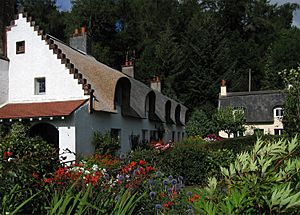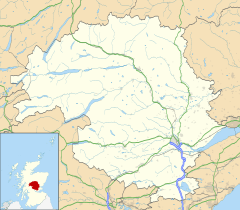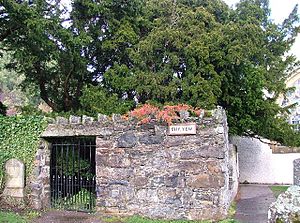Fortingall facts for kids
Quick facts for kids Fortingall
|
|
|---|---|
 Cottages in Fortingall |
|
| OS grid reference | NN739470 |
| Council area | |
| Country | Scotland |
| Sovereign state | United Kingdom |
| Post town | ABERFELDY |
| Postcode district | PH15 |
| Dialling code | 01887 |
| Police | Tayside |
| Fire | Tayside |
| Ambulance | Scottish |
| EU Parliament | Scotland |
| UK Parliament |
|
| Scottish Parliament |
|
Fortingall (Scottish Gaelic: Fartairchill) is a small village in Glen Lyon, Perthshire, Scotland. Its name means "church at the foot of a steep slope." The closest towns are Aberfeldy and Kenmore.
Fortingall is known for a local legend that says it was the birthplace of Pontius Pilate. He was a Roman official famous in the Bible story of Jesus's death. However, he lived long before the Romans came to this part of Scotland. Many other places also claim to be his birthplace. The village is also famous for the Fortingall Yew, a very old tree in the churchyard. It might be over 5,000 years old, making it one of the oldest living things in Europe!
Contents
Fortingall's Old Church
The village's parish church stands on a very old Christian site. It was likely started around 700 AD by monks from Iona, an island known for its early Christian history. Even though there are no old written records, clues like marks in the ground seen from the air and special carvings found nearby suggest it was once a very important church.
Inside the church, there used to be an old hand-bell from the 7th or 8th century, similar to bells found in other parts of the Scottish Highlands. Sadly, this bell was stolen in 2017. In the churchyard, you can see old stone slabs with simple crosses carved into them. There is also a very large, old stone font (a basin for holy water). The current church building, with its nice wooden details, was built in 1901–02. It was designed to fit in with the rest of the village. Fortingall has one of the biggest collections of early medieval (Middle Ages) sculptures in Scotland.
The Ancient Yew Tree
The Fortingall Yew is an amazing old tree. It stands in its own walled area inside the village churchyard. Experts believe it could be between 2,000 and 9,000 years old. The higher estimate means it could be the oldest living tree, or even the oldest living thing, in Europe!
Some clues from old place names and archaeological finds suggest that Fortingall might have been a special religious place in the Iron Age. This ancient tree might have been the main focus of their worship. Later, during the Dark Ages, the site became Christian, possibly because it was already seen as a sacred spot.
A Carefully Planned Village
The pretty village you see today, including the large hotel next to the churchyard, was built around 1890-91. A wealthy shipowner and politician named Sir Donald Currie bought the Glenlyon Estate, which included the village, in 1885.
The architect James M MacLaren designed the village, and John McNaughton built it. The cottages with their thatched roofs are special examples of a "planned village." This means they were built with a specific design in mind, mixing Scottish and English styles. They are now seen as important examples of the "Arts and Crafts" style in Scotland. After some roof fires in the 1970s and 1980s, some thatched roofs were changed to tiles. The Fortingall Hotel was also restored to its original look in 2006–2007. It shows a modern take on old Scottish tower-houses and town buildings.
Exploring Fortingall's Past
The area around Fortingall has many amazing prehistoric archaeological sites. One of these is Càrn nam Marbh, which means 'Cairn of the Dead' in Scottish Gaelic. This was a Bronze Age burial mound that people later used to bury victims of the plague in the 14th century. It was also a central spot for the village's Samhain festival.
Other interesting sites include the Fortingall stone circle and various standing stones. There are also "four-poster" stone settings and "ring-forts," which were large Iron Age house enclosures. You can also find many stones with mysterious cup and ring marks, including one found in the churchyard. There's even a very well-preserved medieval homestead moat. Early historians thought it might be Roman because of its neat shape.
Fortingall parish, which now includes Glen Lyon, is one of the largest in Scotland. Glen Lyon is famous for its beautiful mountain views and many archaeological sites. It is also the country's longest enclosed glen, or mountain valley.
Gallery






